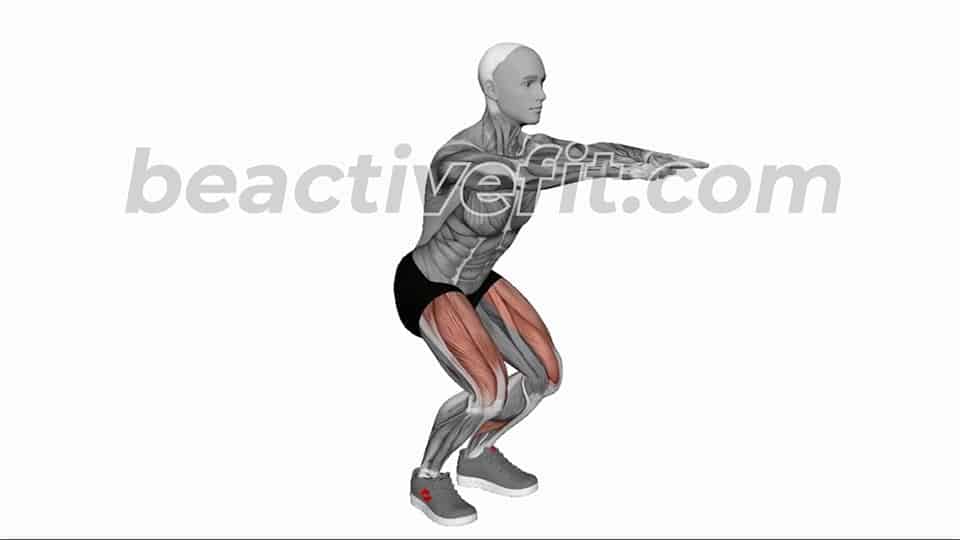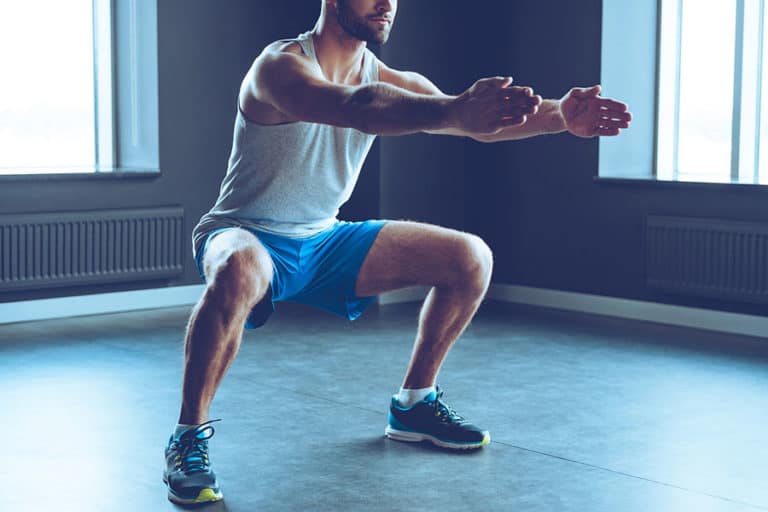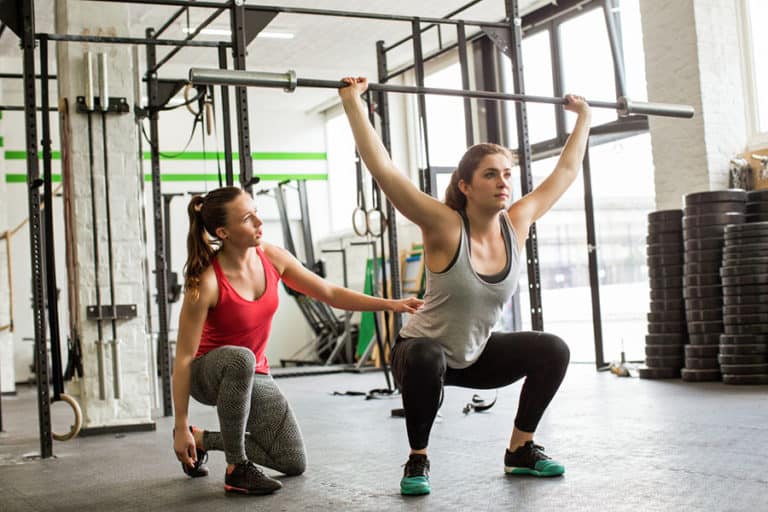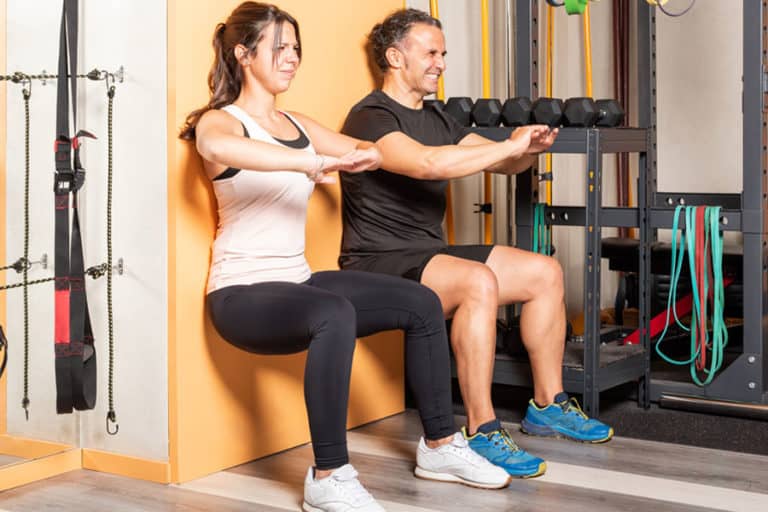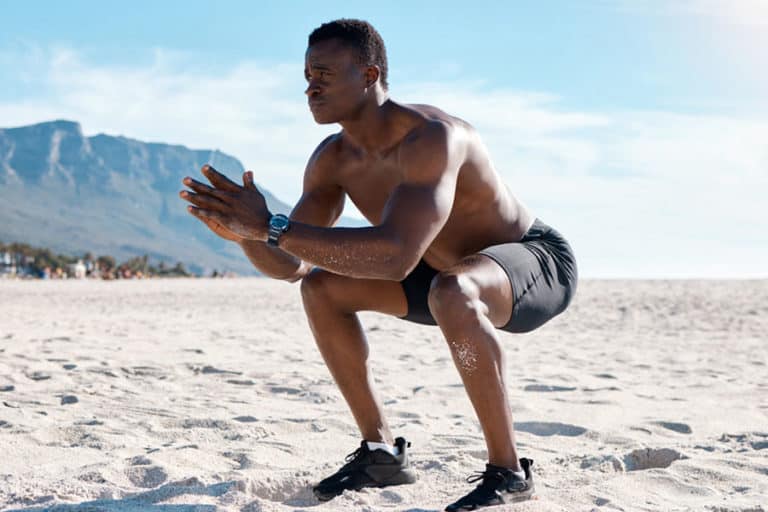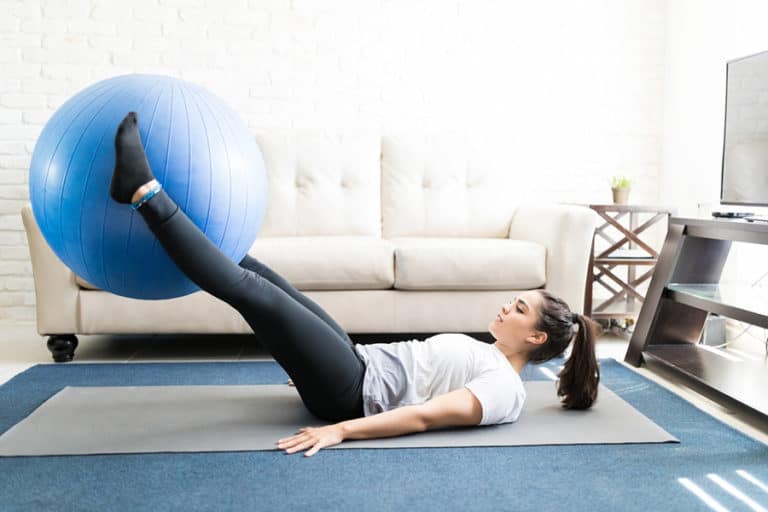Air Squats – Technique, Benefits, And Tips

Definition | How to do | Muscles worked | who should/should not | Add to routine | Safety tips | Benefits | Variations | FAQs
Air squats are a foundational exercise form. These are a type of squats that work the body by using fundamental, functional movements that have always been part of our daily lives.
However, air squats are more than an unintentionally performed exercise. Since they are more challenging than regular squats they are a CrossFit essential and an important part of HIIT squat workouts.
What are air squats?
Air squats are a simple yet effective exercise that involves standing with feet shoulder-width apart, squatting down as low as possible.
Air squats exercise involves the movement of hands and the engagement of the core as well. It can therefore be considered full body squats.
It targets the muscles in the legs, hips, and glutes, and can be done without any equipment. These squats are a great workouts for stronger legs and overall functional fitness.
How to do air squats?
Air squats require no additional equipment. They use only your body weight to tone up your lower body. Hence, they are also known as bodyweight squats. Here is how you can perform the air squat properly:
- Start with your feet shoulder-width apart and toes pointed slightly outward.
- Ensure your weight is in your heels and keep your chest up.
- Let your hands hang loose in a neutral position.
- Position yourself like you’re going to sit in a chair while engaging your core. Keep your knees behind your toes and your hips and shoulders square.
- Let your hips descend lower than your knees.
- As you lower yourself, extend your hands forward until they are in front of your chest.
- Press through your heels, and extend your hips and knees to return to the starting position.
Muscles worked in air squats
The air squat is a compound exercise that works multiple lower body muscles simultaneously. Here is a detailed and split-up understanding of the muscles worked while performing air squats:
Primary muscles worked:
| Quads | musculus quadriceps femoris |
| Buttock muscle | gluteus maximus muscle |
| Posterior thigh muscles/hamstrings | semimembranosus, Biceps femoris, Musculus semitendinosus |
Secondary muscles activated:
| Back extensor | musculus erector spinae |
| Obliques | frontal and lateral abdominal muscles |
| Abs | rectus abdomini |
Who should and should not do air squats?
Any person can perform air squats irrespective of their fitness levels (beginner, intermediate, advanced). However, here’s a list of specific categories of people that should or should not perform air squats:
Who should do air squats?
- Air squats are a must-have for beginners. It allows you to learn the proper form to build a solid foundation to advance to weighted squats like goblet squats..
- Although air squats are beginner-friendly, people on an intermediate or advanced level can use them as a part of their warm-up.
- As air squats are primarily done in leg workout routines. Anyone interested in building their lower body strength, mobility, and overall endurance can do this exercise.
Who should not do air squats?
- Anyone with a previous medical history of injuries should not perform this exercise without consulting their fitness instructor or health care provider.
- People experiencing back pain or knee pain should not perform any kind of squats without the approval of their healthcare provider.
- Fitness enthusiasts aiming to bulk up should not be doing air squats alone. However, the exercise can always be part of an elaborate routine.
Adding it to your routine
Strategically adding this exercise to your routine is extremely important. It allows your body to exert energy more systematically. Here’s how you can add air squats into your routine:
Based on your fitness level
Beginner level: 4-5 sets of 5-8 reps, 2-3 times a week.
Intermediate/Advanced level: 5-6 sets of 10-15 reps, 3 times a week.
Incorporating the air squats into your circuit
If you are a beginner planning to start a regular workout routine, try this circuit to incorporate air squats into your fitness regimen:
| Beginner level exercises | Sets and Reps |
| Jumping jacks(as a warm-up) | 2 sets of 20 reps |
| Pushups | 2 sets of 10 reps |
| Air squats | 3 sets of 5 reps |
| Walking lunges | 3 sets of 5 reps |
| Child pose (cool down) | 1-2 minute |
People with intermediate to advanced levels of fitness, who need a more challenging workout can try this sample workout plan:
| Intermediate/Advanced level exercises | Sets and Reps |
| Air squats (as a warm-up) | 5 sets of 12 reps |
| Russian twist with weights | 2-3 sets of 10 reps |
| Push-ups | 3-4 sets of 10-12 reps |
| Kettlebell swings | 3-4 sets of 12-15 reps |
| Bench dips | 3 sets of 10 reps |
| Child pose and cat-cow pose (cool down) | 1-2 minute |
Note: You may increase the number of reps, sets, or exercises to include as per your personal requirement. Do not push yourself beyond your endurance levels, as it may cause injury.
If you are goal-oriented and want a challenge, here’s a 30-day squat challenge by coachmag [1]Coach Mag: Try The 30-Day Squat Challenge To Build Functional Muscle that incorporates the air squat.
Safety tips
Focusing on the proper squat form is absolutely essential when performing squats. Nonetheless, ignoring the other safety precautions is also dangerous and may lead to injury.
Given below are some safety tips for you to follow:
1. Warm-up
Warm up your muscles before squatting to prevent injuries. Include dynamic stretching [2]Hospital for Special Surgery: Static vs. Dynamic Stretching: What Are They and Which Should You Do? or light cardio, such as jogging in place or jumping jacks.
2. Position your feet properly
Place your feet hip-width apart to maintain a proper balance. Positioning your feet too wide or too narrow can cause injuries. Your stance should shift your weight to the heels.
3. Ensure correct knee position
Keep your knees in line with your toes to avoid instability and injury.
4. Drive up through your heels
Do not drive up through your toes or butt, as that may add unnecessary strain to your lower back and shin bones.
5. Maintain correct posture
Engaging your core muscles and keeping your chest lifted and tall will help you maintain a good balance and posture.
Moreover, if you do not maintain a proper air squat form, your lower back will start to round. That can lead to injuries.
Complete the range of motion
Ensure that you dip your hips beyond your knees. If not, you may not reap the full benefits of the exercise.
Benefits of air squats
Including an air squat workout in your workout routine offer a host of benefits.
Here is a list of air squats benefits:
- Performing these squats prevents you from the risk of injury as they are bodyweight squats, and do not use any external weight.
- Air squats are frequently a part of high-intensity workouts. Thus performing squats can build your endurance [3]National Library of Medicine: The Effect of Two Different Concurrent Training Programs on Strength and Power Gains in Highly-Trained Individuals.
- The range of motion of air squats can help improve your hip and knee mobility.
- Air squats also help improve your balance and coordination as you have to control your body throughout the entire movement.
- Doing a set or two of air squats can get your blood pumping. Thus, this helps improve your heart health [4]Johns Hopkins Medicine: 3 Kinds of Exercise That Boost Heart Health and reduces your risk of heart disease.
- Air squats are an anaerobic exercise [5]Libre Texts Medicine: 10.3: Anaerobic Exercise that can help increase your metabolism, burn fat [6]Piedmont: The benefits of anaerobic exercise and promote weight loss.
Variations to Try
To move on to more challenging workout routines, you may include the below-given variations:
1. Jump squats
While performing jump squats, start in the same position as a basic air squat. Then jump explosively into the air, landing softly back into the squat position. This variation is a great way to add some cardio to your routine and get your heart pumping.
2. Pistol squats
To perform pistol squats, start in a standing position with one leg extended out in front of you and the other leg bent with the foot placed flat on the floor. Keeping your chest up and core engaged, lower yourself down into a squat past the parallel.
Return to the starting position and repeat on the other leg. This variation of the air squat form is a bit challenging, as you are working with one leg only, but the results are definitely worth the effort.
3. Side-to-side squats
This variation of the air squat is a great way to improve your balance and coordination.
To do this squat variation, start by standing with your feet shoulder-width apart. Then, squat down to one side and rise to the start position. Move a little bit to the other side before you get into the next squat. Repeat this movement on the other side.
4. Deep knee bends
Deep knee bends have the same starting position as a basic air squat. However, when you lower yourself into the squat position, bring your hips all the way down to the heels while naturally lifting your heels.
Allow all the body weight onto your toes. Return to the start position by pushing through your toes and then making your heels flat.
Conclusion
In a nutshell, air squats are an exercise that builds a solid strength foundation for your legs. Follow the steps mentioned above and try the variations keeping the safety tips in mind, to make your leg day workouts worth it.
FAQs
We have put together six frequently asked questions about air squats to clear any more doubts or questions you might possibly have regarding this extremely beneficial squat form.
Why are air squats so hard?
Air squats can be hard because they rely on the strength and stability of your own bodyweight, making them a challenging exercise for beginners or those with weak muscles.
What is air squat good for?
Air squats are a simple leg workout that can improve lower body strength, endurance, and flexibility. This exercise targets the muscles in the legs, hips, and glutes, helping to build muscle and improve balance and stability.
Are air squats good for knees?
Air squats are generally safe for knees when done with proper form. Nevertheless, those with knee injuries or pre-existing joint conditions should consult a doctor before attempting these squats.
How many reps of air squats should I do?
The number of reps of air squats you should do depends on your fitness level and goals, but starting with 3 sets of 10-12 reps is a good place to begin.
Do air squats burn thigh fat?
While air squats alone won’t necessarily burn thigh fat, incorporating them into a regular exercise routine and maintaining a healthy diet can help reduce overall body fat.
Do air squats build muscle?
Air squats can build muscle in the legs, hips, and glutes, but may not be as effective for building significant muscle mass as weighted exercises.
References
| ↑1 | Coach Mag: Try The 30-Day Squat Challenge To Build Functional Muscle |
|---|---|
| ↑2 | Hospital for Special Surgery: Static vs. Dynamic Stretching: What Are They and Which Should You Do? |
| ↑3 | National Library of Medicine: The Effect of Two Different Concurrent Training Programs on Strength and Power Gains in Highly-Trained Individuals |
| ↑4 | Johns Hopkins Medicine: 3 Kinds of Exercise That Boost Heart Health |
| ↑5 | Libre Texts Medicine: 10.3: Anaerobic Exercise |
| ↑6 | Piedmont: The benefits of anaerobic exercise |


